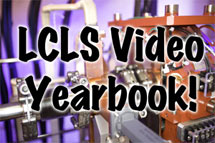

Thursday - July 1, 2010
SLAC Today is
available online at:
http://today.slac.stanford.edu
In this issue:
First Results from the LCLS: Unpeeling Atoms and Molecules from the Inside Out
SSRL Celebrates Frequent-injection Mode Success
This is LCLS: A Video Yearbook
Calliope Quartet Concert Today
 |
 |
|
Thursday - July 1, 2010 |
First Results from the LCLS: Unpeeling Atoms and Molecules from the Inside OutThe world's first hard X-ray free-electron laser started operation with a bang. First experiments at SLAC National Accelerator Laboratory's Linac Coherent Light Source stripped electrons one by one from neon atoms (illustrated above) and nitrogen molecules, in some cases removing only the innermost electrons to create "hollow atoms." Understanding how the machine's ultra-bright X-ray pulses interact with matter will be critical for making clear, atomic-scale images of biological molecules and movies of chemical processes. (Image: SLAC InfoMedia Solutions.)
The first published scientific results from the world's most powerful hard X-ray laser, located at the Department of Energy's SLAC National Accelerator Laboratory, show its unique ability to control the behaviors of individual electrons within simple atoms and molecules by stripping them away, one by one—in some cases creating hollow atoms. These early results—one published today, the other last week—describe in great detail how the Linac Coherent Light Source's intense pulses of X-ray light change the very atoms and molecules they are designed to image. Controlling those changes will be critical to achieving the atomic-scale images of biological molecules and movies of chemical processes that the LCLS is designed to produce. In a report published in the July 1 issue of Nature, a team led by Argonne National Laboratory physicist Linda Young describes how they were able to tune LCLS pulses to selectively strip electrons, one by one, from atoms of neon gas. By varying the photon energies of the pulses, they could do it from the outside in or—a more difficult task—from the inside out, creating so-called "hollow atoms." "Until very recently, few believed that a free-electron X-ray laser was even possible in principle, let alone capable of being used with this precision," said William Brinkman, director of DOE's Office of Science. "That's what makes these results so exciting." Read more... SSRL Celebrates Frequent-injection Mode SuccessLast Friday staff and users from the Stanford Synchrotron Radiation Lightsource gathered at the SLAC guest house to celebrate the recent transition of SPEAR3 operations to frequent-injection mode. This operating mode replenishes the storage ring current with about 1.5 mA every ten minutes to maintain constant power on beamline optics and stable X-ray intensity at the user stations. Accelerator Directorate physicist John Schmerge said the operation has been "a tremendous success so far." SSRL began its first user operations in frequent-injection mode on June 7—after five years of planning, upgrading and testing—and has run smoothly since. This is the result of close collaboration between SSRL, the Accelerator Directorate and Radiation Physics. "This was a big effort by a lot of people, and this is our way to thank them," said SSRL Acting Director Piero Pianetta. "The users are really happy." But the work isn't finished quite yet. SPEAR3 currently operates at 200 mA; during the FY2011 run, the SPEAR3 current will be increased up to 500 mA in several steps as the beamlines are qualified by Radiation Physics staff and tested at higher currents by the SSRL Beamline group.  This is LCLS:
|
Events
Access (see all)
Announcements
|
|
| | ||
|
|
||
 <%
Response.AddHeader "Last-modified", getArticleDate()
'Response.AddHeader "Last-modified","Mon, 01 Sep 1997 01:03:33 GMT"
'Monday, December 06, 2010
%>
<%
Response.AddHeader "Last-modified", getArticleDate()
'Response.AddHeader "Last-modified","Mon, 01 Sep 1997 01:03:33 GMT"
'Monday, December 06, 2010
%>View online at http://today.slac.stanford.edu/. |
||